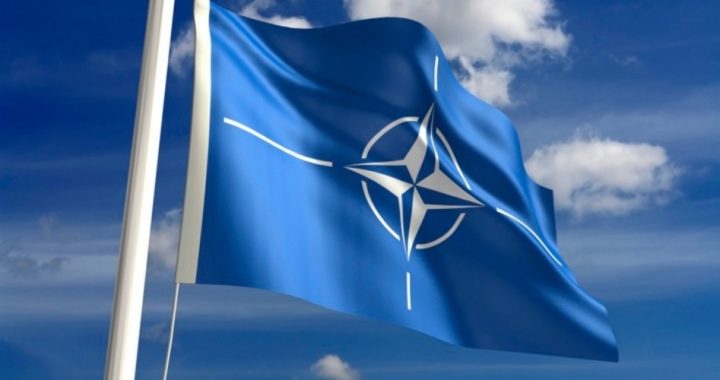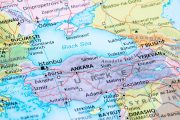
At the end of the month marking the centenary of the start of World War I, Great Britain appears to be readying once again the “Guns of August,” this time in alliance with fellow members of the North Atlantic Treaty Organization.
Britain is spearheading the creation of a new NATO rapid deployment force in response to the escalating crisis in the Ukraine, the Financial Times reported Friday. Other members reportedly ready to commit troops to the planned expeditionary force of 10,000 are Denmark, Latvia, Estonia, Lithuania, Norway, and the Netherlands. According to the National Post in Canada, as many as 1,000 Canadian troops are expected to join the force, which will rotate through NATO bases in Eastern Europe. It will be the first time that Canada deployed that many troops “across the pond” since it closed two bases in Germany’s Black Forest when the Cold War formally ended, the Post noted.
British Prime Minister David Cameron is expected to declare the formation of the new force at the upcoming NATO summit in Wales on September 4. The move comes in response to NATO’s report of a Russian deployment of more than 1,000 troops into eastern Ukraine in support of rebels fighting there for independence from Kiev. Russia’s reaction has been to brand the report a false accusation.
“It’s not the first time we’ve heard wild guesses, though facts have never been presented so far,” Foreign Minister Sergey Lavrov said at a Moscow press conference. “There have been reports about satellite imagery exposing Russian troop movements. They turned out to be images from videogames. The latest accusations happen to be much the same quality,” he claimed.
The division-sized NATO force will integrate air and naval units with ground troops led by British commanders, the Financial Times said, with the goal of creating a force for rapid deployment and frequent military exercises. While the United States is not named as part of the new expeditionary force, the mutual defense agreement of the NATO pact is binding on all members, so any conflict between Russia and Great Britain or any of the other members of the rapid deployment force could draw the United States into war — despite the fact that under the U.S. Constitution the power to declare war belongs to Congress.
NATO has no plans to intervene militarily in Ukraine, Foreign Policy magazine reported, quoting unnamed sources saying the alliance plans to confront Russia with nothing more than stronger economic sanctions.
But there is a need to demonstrate that NATO’S eastern European members are as integral to the alliance as other states, Jonathan Eyal of the London-based Royal United Services Institute said.
“We need to end the idea of different zones of security in Europe,” Eyal told the Times. “We need to be talking about prepositioning, regular rotation of troops and making it very clear that we do not accept that the eastern Europeans are in some different category of membership of NATO.”
At his press conference on Thursday, President Obama spoke out again against the Russian involvement in the fighting in Ukraine. “The separatists are backed, armed, trained, financed by Russia,” said the president, adding the United States and its NATO allies may be looking to increase economic sanctions that are already hurting and isolating Russia. “And I think there are ways for us to deepen or expand the scope of some of that work,” he said, noting it will be the subject of consultations when he attends this week’s NATO summit.
NATO was formed by the United States and western European Nations in 1949 as a defensive alliance against the Soviet Union. U.S. troops were stationed in Europe on what was understood to be a temporary mission, providing a shield against Soviet aggression for America’s west European allies while they recovered from the devastation of World War II. When General Dwight D. Eisenhower assumed command of NATO forces in 1951, he said: “If in 10 years, all American troops stationed in Europe for national defense purposes have not been returned to the United States, then this whole project will have failed.” Yet 69 years after the end of World War II and nearly a quarter of a century after the end of the Soviet era in 1991, approximately 68,000 U.S. troops are still in Europe. In the post-Soviet era, NATO was expanded to include Poland, Hungary, the Czech Republic, and other former nations in the Soviet bloc. Latvia, Estonia, and Lithuania were member-states of the Soviet Empire. NATO expansion has increased the number of member nations from the original 12 in 1949 to 28 today.
In recent years members of Congress, including Vice President Joe Biden and former Republican presidential nominee John McCain, have called for bringing the former Soviet state of Georgia into the alliance, which would commit the United States and other NATO nations to a defense of Georgia in any military conflict with Russia. “Today, we are all Georgians,” John McCain said during his presidential quest in 2008 after Russian forces intervened in the fighting between Georgia and South Ossetia.
Ukraine applied for NATO membership in 2008, but plans were shelved after the 2010 election of pro-Russian president Viktor Yanukovych. Yanukovych chose to follow a policy of non-alignment rather than integration with the European nations seeking increased economic and political influence with Ukraine. He was ousted in a coup encouraged by the U.S. State Department in February of this year. The fighting by pro-Russian separatists against the new Kiev government and the movement of Russian troops into the former Russian territory of Crimea have been the source of the latest sabre rattling between Russia and the West reminiscent of the Cold War era.
Crimea’s parliament in late March voted to break away from Ukraine and join the Russian Federation, one day after a huge majority of voters chose that option in a referendum that was condemned as a sham in Washington and across Europe. Crimean election officials reported that with 83.1 percent of the eligible population voting, 96.77 percent favored union with Russia and 2.51 percent voted against it. The United States and European nations promptly slapped financial sanctions and a travel ban on Russian and Ukrainian authorities responsible for the Russian push into Crimea and the support for the referendum.
Ties between Russia and Ukraine go back to a time before both became separate nations in the 18th century. Russia annexed Crimea in 1783 but ceded it to Ukraine in 1954 (though this was a distinction without a difference, since the Soviets controlled Ukraine). While Senators McCain, Lindsey Graham (R-S.C.), and others in Congress have called for sending arms to aid Ukraine in its fight against the Russian-supported separatists, U.S. or NATO intervention with arms in a war in a non-member nation on the Russian border appears likely to further inflame the crisis and possibly draw the United States and its allies into a war we neither need nor can afford. There could hardly be a better time or place for the United States to heed Washington’s and Jefferson’s warnings against “entangling alliances” — especially since we have no alliance with Ukraine in the first place.
Photo: NATO flag



